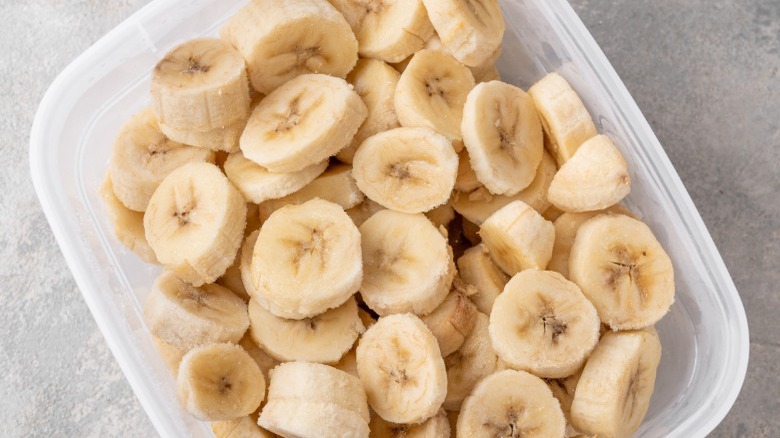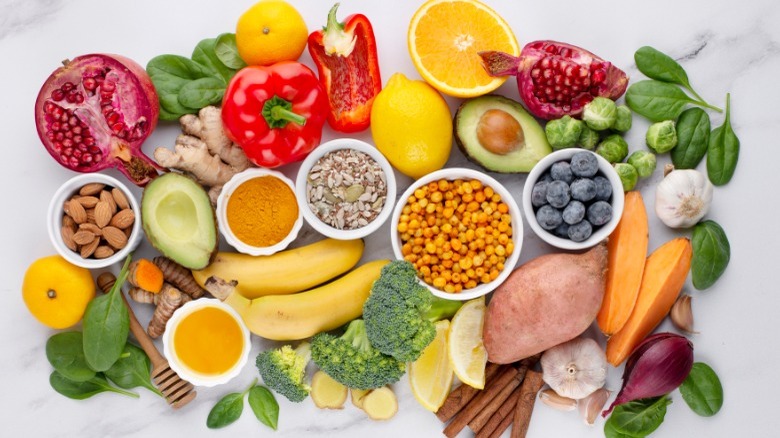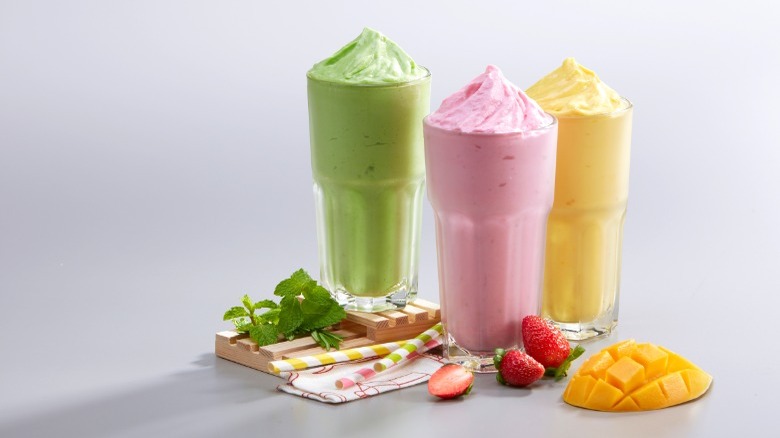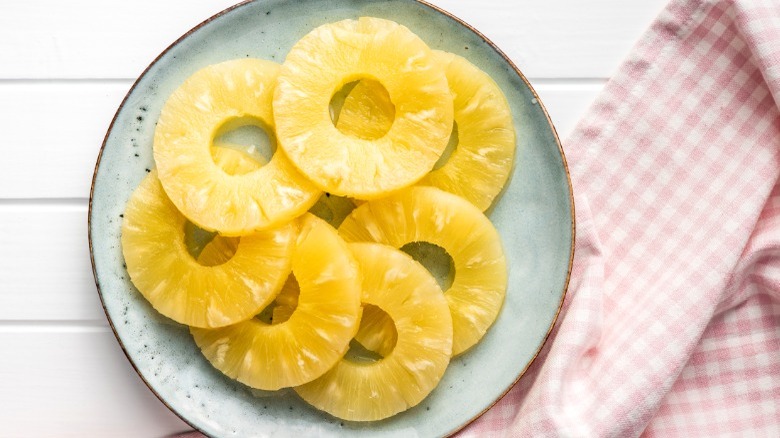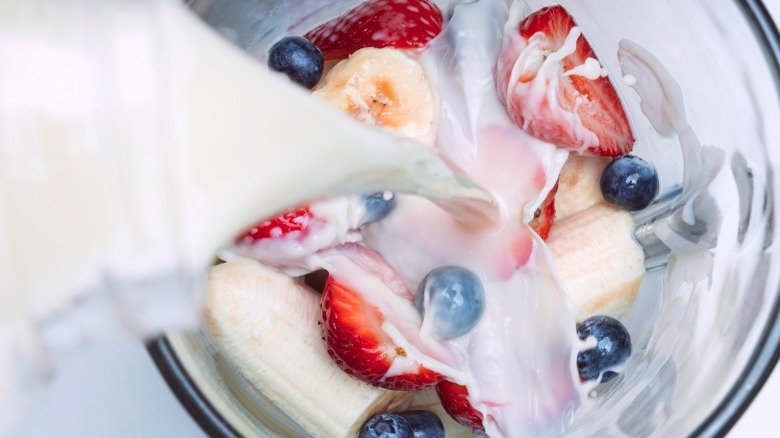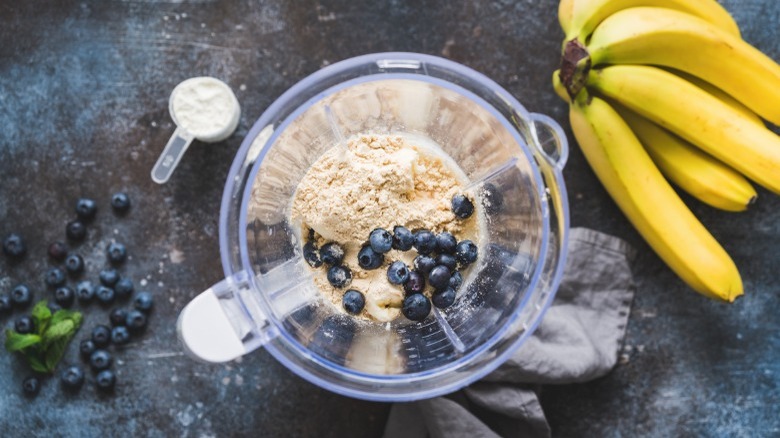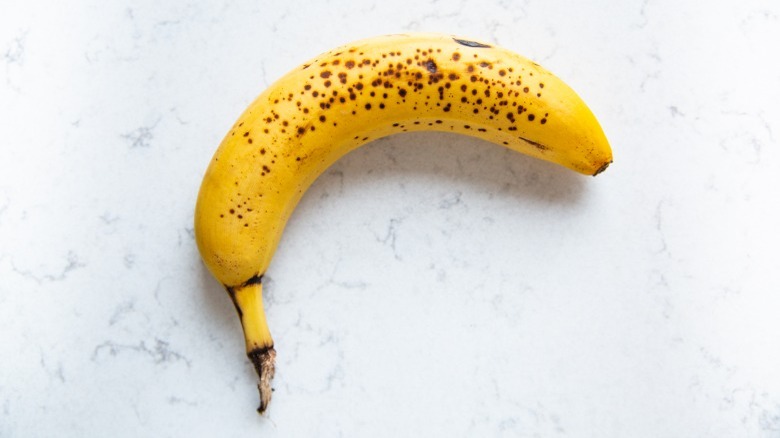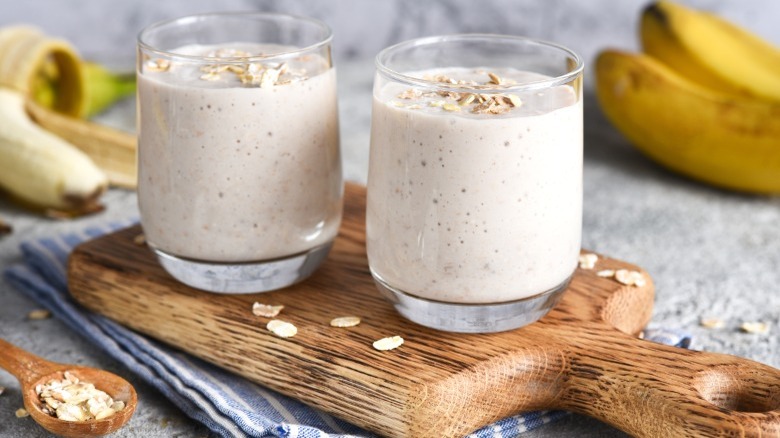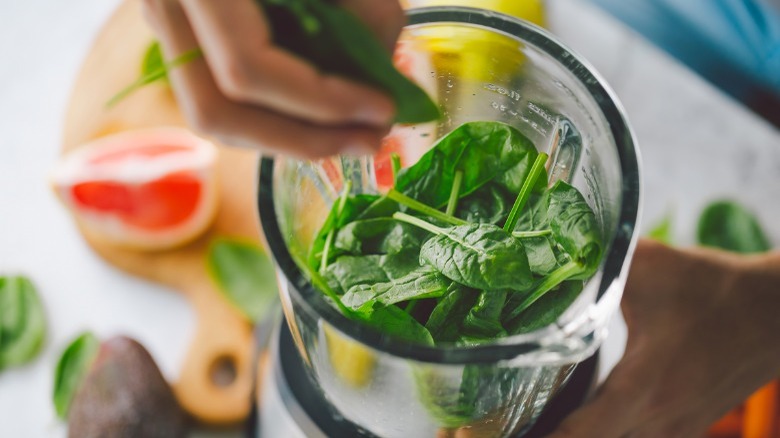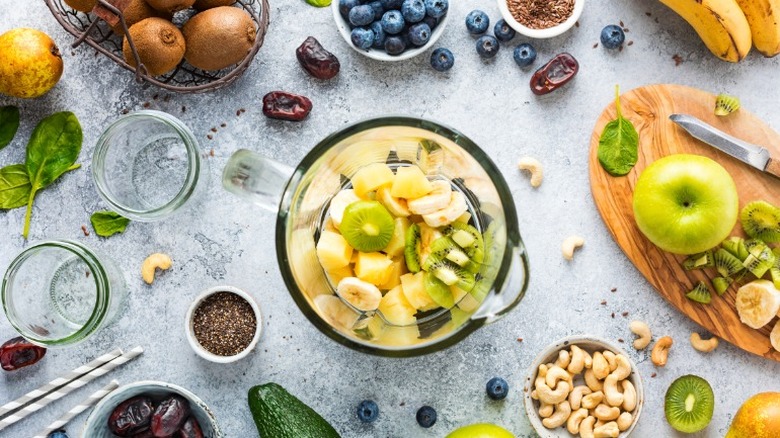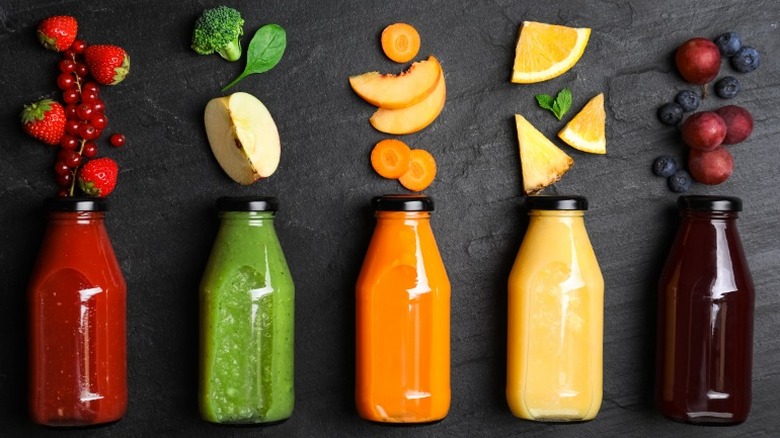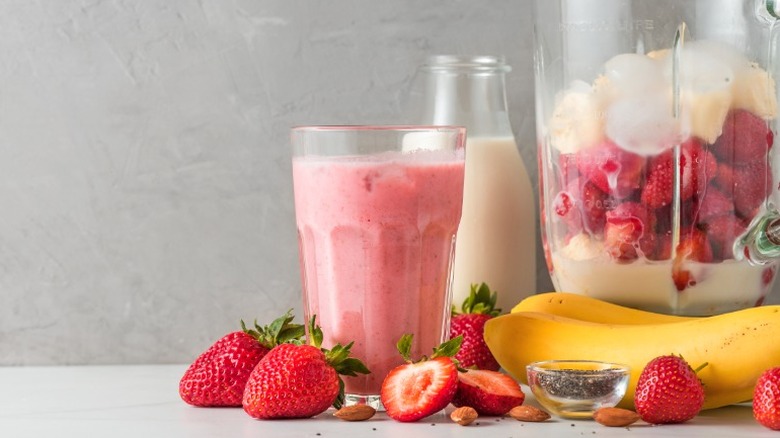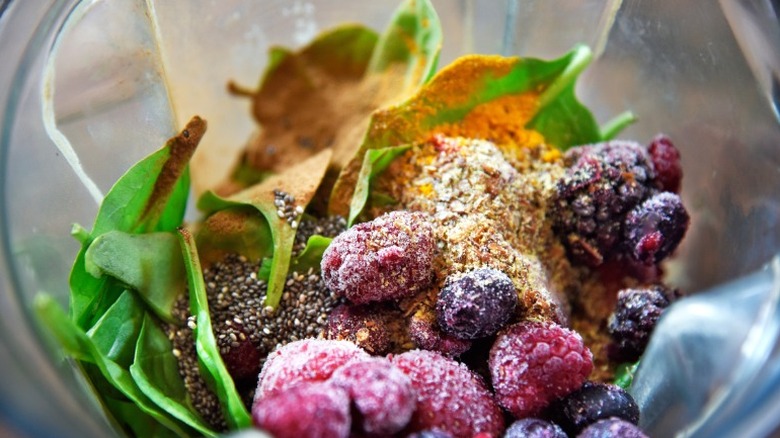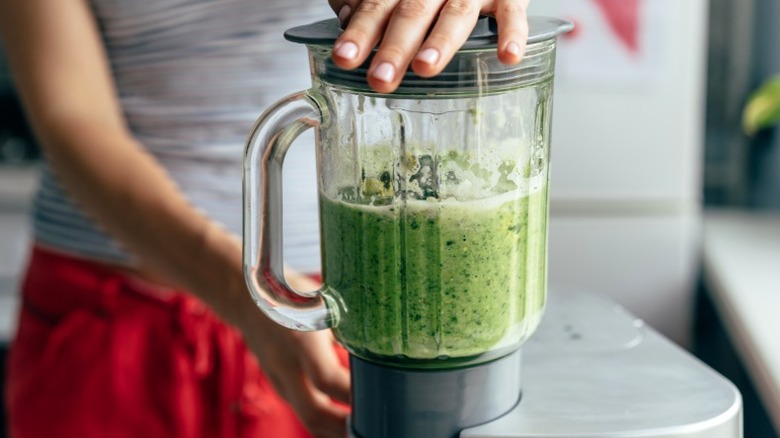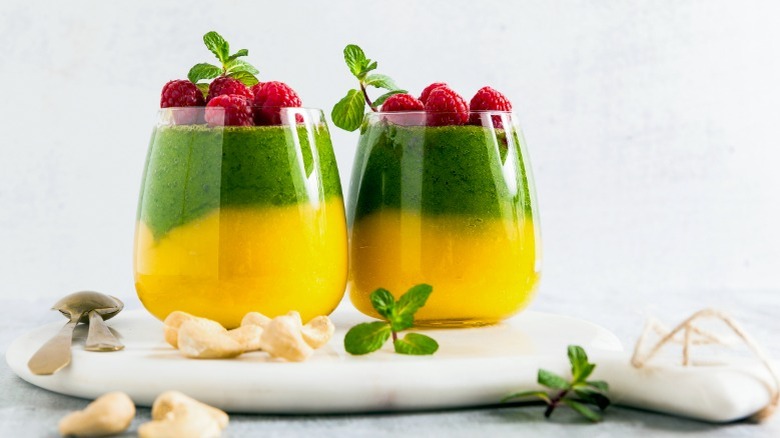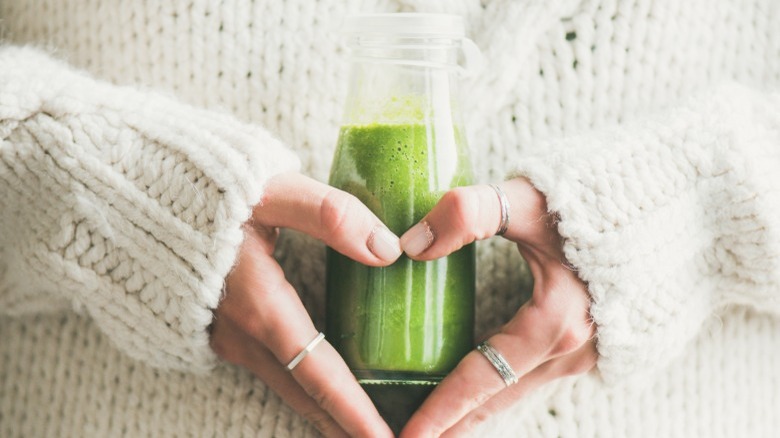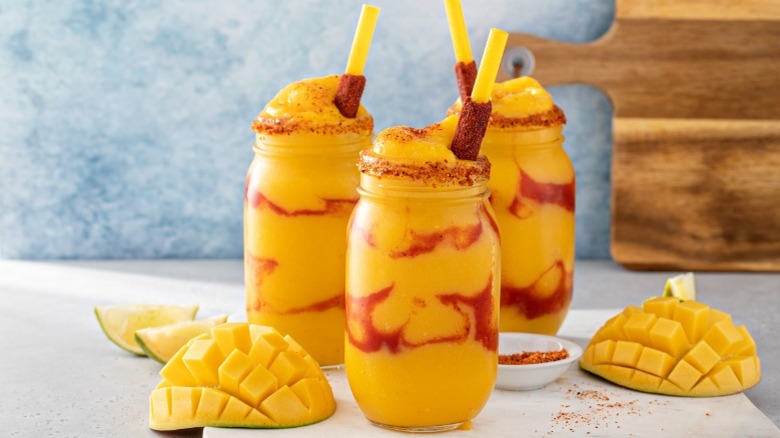19 Tips You Need For A Perfect Smoothie
A refreshing, nutritious, and highly customizable beverage, the smoothie has been conquering America for almost a hundred years, according to Smoothie King. It gained widespread popularity in the 1990s after the introduction of high-speed blenders. With the increasing interest in plant-based diets, smoothie-making continues to grow in popularity, but there are secrets to getting it right.
Whether you're looking for a quick breakfast or want to boost your energy mid-afternoon, a smoothie is the answer. However, it can be easy to fall into a smoothie rut or unintentionally hinder its nutritional value. From selecting the best ingredients to proper layering techniques, these tips will help you create smoothies that taste great and deliver all the nutrients you need. So if you're looking to perfect your smoothie-making skills, look no further: Even if you're a smoothie novice, following these tips will help you blend in with the pros.
Skip the ice — freeze your fruit instead
Throwing a few ice cubes into the blender might seem a great way to make your smoothie more refreshing, but it's a common mistake. The reason you should never add ice to a smoothie has everything to do with flavor and consistency. Once it melts, the ice can water down the smoothie, making it bland and thinner than desired. The best way to achieve that thick and frosty texture without sacrificing flavor is to freeze the fruit, especially bananas. The freezing process helps to lock in the fruit's natural sweetness and enhance the smoothie's overall flavor. So the next time you're making a smoothie, skip the ice and use frozen fruit instead. It'll help you create a rich and creamy smoothie without compromising flavor.
Incorporate multiple food groups
Smoothies are a low-effort way to make sure you get enough nutrients. For one, they can increase your dietary fiber intake, which is essential considering most Americans get only half the amount they should, (per University of California San Francisco). However, simply mixing fruits and liquids is one of the biggest mistakes people make with smoothies. Instead, you should try to mix & match different food groups — fruits, vegetables, healthy fats, and proteins. For fiber, use whole grains such as oats or bran. Fruits, vegetables, and berries will also add fiber, as well as vitamins and antioxidants. Healthy fats can be obtained from avocados, nut butter, flax, chia, and hemp seeds. Finally, use protein powder, peanut butter, or silken tofu for protein. Try incorporating at least three groups each time you make a smoothie, and you'll be set for the day.
Keep track of the sugar content
Have you ever noticed some smoothies don't seem very filling? Perhaps you are not making (or drinking) the right kind of smoothies. You may want to reconsider having fruit smoothies for breakfast since they could negatively affect blood sugar levels, particularly the store-bought varieties. A sudden spike in blood sugar can cause fatigue, headache, increased thirst, and blurred vision, (via Healthline).
If you're monitoring your sugar intake, pre-packaged smoothie fans should read the labels carefully, or you could opt for making smoothies at home. This way, you can have control over what goes into your smoothie, which will affect the taste and how it makes you feel. Thus, a simple green smoothie chock-full of berries, bananas, mangos, and greens won't spike up your blood sugar, but it will provide lots of nutrients that'll leave you with more sustaining energy.
Avoid using canned or dried fruit
A smoothie novice might be tempted to use any kind of fruit they have on hand, but it's not always the best idea since some can negatively impact the quality and healthfulness of the smoothie. Canned fruit is a bad choice for smoothies because it often comes in sweet syrup, leading to an excess of unnecessary sugars in your drink that will lead to that quick spike in energy and then a hard crash. Dried fruit, on the other hand, should never be put in a blender. What it will do is stick to the blades, and what it won't do is help you achieve a uniform drink. You can counter these issues by rinsing the canned fruit and soaking the dried ones, but it's best to opt for fresh or frozen fruit instead. These options will provide the best taste and texture without causing damage to your blender.
Watch the consistency
Achieving the perfect consistency in a smoothie can often be a challenge, but there are several ingredients that can help you achieve it. One of the secret ingredients for perfectly thick smoothies is xanthan gum, which acts as a natural thickener that prevents separation. Additionally, using frozen bananas as a base for your smoothie can help create a thicker consistency, as well as add a creamy, sweet flavor. Incorporating nut butter, such as almond or peanut butter, can also help create a thicker drink and provide a boost of healthy fats. If your smoothie ends up too thick, you can thin it out by adding coconut water or dairy-free milk. With the right ingredients and a bit of experimentation, you can easily create a delicious and perfectly thick smoothie every time.
Skip the dairy base
Using dairy as a base for your smoothies has its downsides. One concern is the added sugars that often come with dairy products, particularly fruit yogurts. Additionally, combining dairy with berries may actually prevent the beneficial effects of their nutrients, as their absorption can be blocked by dairy. While milk proteins used to be blamed for it, it was recently found that full-fat milk has the worst effect on fruit nutrient absorption, which suggests that dairy fat might be the real culprit (per NutritionFacts.org). Fortunately, there are over a dozen types of plant milk to choose from. By skipping the dairy base and opting for a plant-based alternative, you can ensure that the beneficial effects of your fruit are not blocked.
Pack them with superfoods
Experimenting with superfoods can be a great way to enhance the nutritional value of your smoothies and add new, exciting flavors and hues. There are plenty of ways to boost your smoothies with superfoods, including seeds, powders, extracts, and oils that might not be palatable on their own but can do wonders in a refreshing blended drink. Some popular superfoods to add include chia seeds, cinnamon, MCT oil, and maca powder. To get the most out of your superfood ingredients, pay attention to what you're mixing them with. For example, aloe vera would work wonders in a green smoothie, while cacao pairs well with bananas and nut butter. Slightly bitter matcha and spirulina pair well with sweet fruit. Additionally, consider combining different superfoods to create unique and nutritious blends. By experimenting with different ingredients, you can create delicious smoothies that will provide a wide range of health benefits.
Make them your source of protein
Maximizing your healthy protein intake with smoothies is easy. One option is to add a protein powder, but you can also add whole-food plant-based proteins. For a fuss-free protein boost, consider adding ingredients like spirulina, which contains around 8 grams of protein per 2 tablespoons, or chia seeds, which are a source of complete protein and contain 2 grams of protein per tablespoon. Hemp seeds pack up 5 grams of protein per tablespoon, and peanut butter contains 3.6 grams per tablespoon, (via Medical News Today). If you're looking for a unique twist, you can even add beans to your smoothie. For example, a cocoa-bean smoothie made with bananas, cocoa powder, and rice milk combined with canned black beans can provide a delicious and protein-packed drink. If you incorporate these protein sources into your smoothies, you can turn them into a nutritious and satisfying meal or snack.
Use up overripe fruit
Using up overripe fruit in smoothies is an excellent way to save money, reduce food waste, and get a dose of nutrients. For example, overripe peaches can be pitted, sliced, flash-frozen, and added to the mix, while cutting off the stalks of fresh, ripe figs is the only prep you need for a fig-banana smoothie. To make the most of seasonal produce, stock up and freeze fruits yourself. Berries and small fruits are easy to freeze, and apples and pears can be frozen without peeling the skin. Stone fruit should be sliced and pitted before freezing. When freezing pineapple and watermelon, remove the rinds, and chop the flesh into small pieces while saving the juice for other uses. By having a variety of frozen ingredients on hand, you can always have a delicious and nutritious smoothie ready to enjoy.
Add raw oats for extra texture and fiber
If you're looking for ways to boost fiber and texture in smoothies, look no further than the humble pantry staple you likely have on hand: uncooked oats. The addition of oats not only provides a thicker, creamier texture but also increases the fiber content of your smoothie. One way to incorporate oats into your smoothies is by simply adding ¼ to ½ a cup into your go-to recipe. Alternatively, try the easy iced coffee oat breakfast smoothie recipe, which combines oats, iced coffee, dates, cinnamon, almond milk, and a frozen banana for a creamy breakfast smoothie with a coffee kick. Adding raw oats to your smoothies is an easy way to increase the dietary fiber intake and keep you full longer, so why not try it today?
Sneak veggies and greens in
Good news for all the picky eaters and busy bees out there: Smoothies are here to help you eat more balanced. In fact, adding spinach or kale to your smoothies is the easiest way to incorporate more greens into your diet. They might seem an unwelcome addition to a typically sweet drink, but fruit can overpower their flavor. For example, a Black Forest smoothie recipe that calls for frozen cherries, cocoa powder, and a handful of spinach will help you get in a serving of greens without even noticing. One sneaky way to pack veggies into your meals is to add frozen or cooked vegetables to the mix. If you're on the fence, try making a sweet potato smoothie. Mixing frozen sweet potato, banana, almond milk, and spices creates a creamy and filling drink that's also packed with vitamins and minerals.
Add healthy fats
Incorporating healthy plant fats in smoothies is an easy way to add texture and creaminess to the drink while also providing essential fatty acids and other health benefits. When it comes to tropical smoothies, the unexpected ingredient that will majorly upgrade their flavor is flaxseed. Flaxseed is high in fiber and Omega-3 fatty acids and has a nutty flavor that is a perfect match for tropical fruit. Nuts, seeds, nut butter, and avocados are also great options for making your smoothies creamy and flavorful while adding healthy fats to your diet. For instance, a simple banana avocado smoothie or a peanut butter and jelly smoothie are great ways to enjoy the benefits of healthy plant fats. These ingredients not only provide creaminess to the drink but also help in promoting overall health and wellness.
Opt for whole fruits instead of juice
In case you didn't know, you should never use orange juice in your smoothie. Or any other juice, for that matter, because it contains almost no fiber, yet double the amount of sugar and calories than the fruit it's made from. This matters because most people's diets run low on fiber but are high in sugar, and prioritizing getting that fiber in there is important. Dietary fiber helps maintain gut health and regulate digestion, (via Healthline). If you're still set on using juice, go for small amounts: For example, this vegan mango smoothie recipe only has ¼ cup per serving. However, for the best benefits, it's recommended to use whole, unprocessed fruit or replace juice with water or non-dairy milk. But if you're good on fiber and not caring about that sugar rush then crash, add that orange juice.
Pay attention to the layering order
At a glance, the order in which ingredients are added to a blender may seem unimportant. In reality, it significantly impacts the smoothie's texture and overall outcome. For the best results, pour the liquids in first, followed by soft ingredients like fresh fruits and greens. Then, add the hard ingredients, such as frozen fruit, which will push down the rest. This helps reduce the risk of damage to the blades or the blender itself and creates that signature smoothie vortex. Adding hard ingredients first can cause friction, making it harder for the blender to break down other ingredients. Following these layering rules ensures that your blender lasts longer and your smoothies come out perfectly creamy every time. So, the next time you make a smoothie, remember that, yes, the order you put ingredients into a blender matters.
Use pantry staples to elevate the flavor
A smoothie doesn't need to contain any fancy ingredients to pack a flavor punch. Some of the most common pantry staples can enhance the flavor and boost the health benefits of your smoothies. For example, a dash of salt is known to highlight sweet flavors. Similarly, spices such as cinnamon and turmeric can help to add flavor while also providing numerous health benefits, such as reducing inflammation and boosting the immune system, (via Healthline). One other baking essential you should start blending into your smoothies is vanilla extract. A touch of vanilla will add a natural sweetness to the drink, as well as deepen the flavor of other ingredients. So whenever you feel like a smoothie, don't be afraid to reach for those basic pantry staples — they will take even the simplest smoothie to the next level.
Get a high-performance blender — unless you're a smoothie bowl fan
Ever wondered why your homemade smoothies don't turn out as good as a restaurant's? The main secret to their flawless thick texture is a powerful, restaurant-grade blender. So if you're a real smoothie fan, you might want to splurge on a high-performance smoothie machine (some say a Ninja Personal Blender stands above the rest). While it can be costly, such an appliance will help you forget all the disappointing, grainy, lumpy drinks you used to make at home and save money on having your smoothies elsewhere.
However, if you'd rather scoop than sip, you should stop using a blender. A kitchen processor with a wider bowl is better suited for smoothie bowls, as it allows you to scoop it out easily. Additionally, its wide blades are more effective for breaking down tough ingredients into a smooth, creamy texture.
Layer them like a pro
While smoothies are valued for their convenience and fuss-free preparation, presentation matters — ask anyone who's ever posted a photo of their smoothie on Instagram. If you're not short on time or are celebrating a special occasion with a smoothie, there is a neat bartending trick that will make it look gorgeous. First, blend two or more smoothies that have complementary flavors and contrasting colors. Put your base layer in, and then pour the next one over a spoon that's turned upside down. Repeat until you reach the top of the glass. Be sure to pour slowly and evenly so that the different layers are distinct. If desired, you can also add toppings, like granola or fruit, before serving. This technique creates a beautiful texture, making the smoothie a treat both for the taste buds and the eyes.
Enjoy immediately
Freshly made smoothies contain vitamins, minerals, and antioxidants that start to break down as soon as the ingredients are blended, which is why you should drink smoothies immediately after making them. The longer it sits, the less nutritious it becomes. A smoothie can be stored in the fridge for up to two days, but it's best to drink it within the first few hours after making it. Either way, you must remember that the more time it spends in the fridge, the more it loses in color, taste, and nutritional value. To prevent spoilage, store your smoothies in airtight containers and keep them in the coldest part of your fridge. If you are unsure whether your smoothie is still good to drink, give it a sniff test. If it has an off smell, it's best to discard it and make a new one.
Don't fall into a smoothie rut
If you ever get bored of making the same green smoothie over and over, take the time to get creative with different colors and flavors. Experimenting with new combinations of fruits, veggies, nuts, and spices can keep exciting your palate. Try creating your own seasonal flavors, like a pumpkin pie smoothie in the fall or an easy apple pie smoothie in the winter. Another way to add variety to your smoothie routine is to try different textures, such as adding oats, chia seeds, or nut butter for added creaminess. You can switch up your liquids and opt for coconut water or plant milk instead of just plain water or dairy. Whatever you do, play around with different combinations of fruit, thickeners, add-ins, and liquids.

